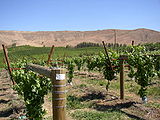Lyra (viticulture)
In Lyra is a quality-oriented Cultivation in viticulture , in which the shoots of vine to be separated such that two vertical walls of foliage created which form a cavity in the center. This growth is reminiscent of the shape of the lyre stringed instrument . The Lyra method was developed in Bordeaux in the early 1980s .
The lyre is a special kind of high quality education. The set-up costs are very high because twice the amount of support material (stakes and wires) is required. The workload is also increased, as the winemaker has to disentangle the canopy two to three times a year in order to restore the space in the middle of the cane.
This form of education leads to a doubling of the exposed leaf surface and thus to an improved use of solar energy. After rain , improved ventilation of the vine and increased surface area allow the leaves to dry faster, so that the risk of powdery mildew is reduced. In addition to a reduced susceptibility of the vine to fungal diseases, savings in crop protection are the advantages of this form of education.
The yield in the lyra is about 2000-3000 liters per hectare.
Lyra education in the Rattlesnake Hills AVA wine region . In the foreground the massive row end fixtures.



